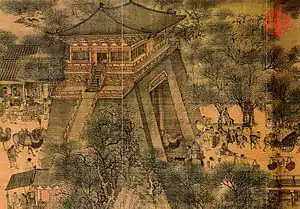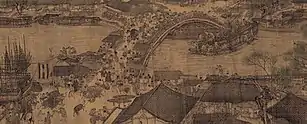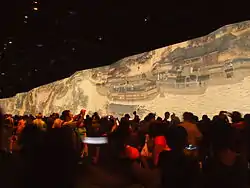Along the River During the Qingming Festival
Along the River During the Qingming Festival, also known by its Chinese name as the Qingming Shanghe Tu (Simplified Chinese: 清明上河图 Traditional Chinese: 清明上河圖), is a painting by the Song dynasty painter Zhang Zeduan (1085–1145). It captures the daily life of people and the landscape of the capital, Bianjing (present-day Kaifeng) during the Northern Song. The theme is often said to celebrate the festive spirit and worldly commotion at the Qingming Festival, rather than the holiday's ceremonial aspects, such as tomb sweeping and prayers. Successive scenes reveal the lifestyle of all levels of the society from rich to poor as well as different economic activities in rural areas and the city, and offer glimpses of period clothing and architecture.[1] The painting is considered to be the most renowned work among all Chinese paintings,[2][3][4] and it has been called "China's Mona Lisa."[5]
| Along the River During the Qingming Festival | |
|---|---|
| 清明上河圖 | |
 A small portion of the painting depicting scenes at the Bianjing city gate | |
| Artist | Zhang Zeduan |
| Year | 1085–1145 |
| Type | Ink and color on silk; handscroll |
| Dimensions | 25.5 cm × 525 cm (10.0 in × 207 in) |
| Location | Palace Museum, Beijing |
| Along the River During the Qingming Festival | |||||||||
|---|---|---|---|---|---|---|---|---|---|
| Traditional Chinese | 清明上河圖 | ||||||||
| Simplified Chinese | 清明上河图 | ||||||||
| Literal meaning | Title can be considered a literal translation; alternatively A Picture up the River at Qingming | ||||||||
| |||||||||
As an artistic creation, the piece has been revered and artists of subsequent dynasties made re-interpretive versions, each following the overall composition and the theme of the original but differing in details and technique.[6] Over the centuries, the Qingming scroll was collected and kept among numerous private owners, before it eventually returned to public ownership. The painting was a particular favorite of Puyi, the Last Emperor, who took the Song dynasty original with him when he left Beijing. It was re-purchased in 1945 and kept at the Palace Museum in the Forbidden City. The Song dynasty original and the Qing versions, in the Beijing and Taipei Palace Museums respectively, are regarded as national treasures and are exhibited only for brief periods every few years.[7]
The Song original
The scroll is 25.5 centimetres (10.0 inches) in height and 5.25 meters (5.74 yards)[8] long. In its length there are 814 humans, 28 boats, 60 animals, 30 buildings, 20 vehicles, 8 sedan chairs, and 170 trees.[1] Only about twenty women appear in the Song dynasty original, and only women of low social rank are visible out of doors unless accompanied by men.[9]
The countryside and the densely populated city are the two main sections in the picture, with the river meandering through the entire length. The right section is the rural area of the city. There are crop fields and unhurried rural folk—predominately farmers, goatherds, and pig herders—in bucolic scenery. A country path broadens into a road and joins with the city road. The left half is the urban area, which eventually leads into the city proper with the gates. Many economic activities, such as people loading cargoes onto the boat, shops, and even a tax office, can be seen in this area. People from all walks of life are depicted: peddlers, jugglers, actors, paupers begging, monks asking for alms, fortune tellers and seers, doctors, innkeepers, teachers, millers, metalworkers, carpenters, masons, and official scholars from all ranks.

Outside the city proper (separated by the gate to the left), there are businesses of all kinds, selling wine, grain, secondhand goods, cookware, bows and arrows, lanterns, musical instruments, gold and silver, ornaments, dyed fabrics, paintings, medicine, needles, and artifacts, as well as many restaurants. The vendors (and in the Qing revision, the shops themselves) extend all along the great bridge, called the Rainbow Bridge (虹橋 Hong Qiao) or, more rarely, the Shangdu Bridge (上土橋).
Where the great bridge crosses the river is the center and main focus of the scroll. A great commotion animates the people on the bridge. A boat approaches at an awkward angle with its mast not completely lowered, threatening to crash into the bridge. The crowds on the bridge and along the riverside are shouting and gesturing toward the boat. Someone near the apex of the bridge lowers a rope to the outstretched arms of the crew below. In addition to the shops and diners, there are inns, temples, private residences, and official buildings varying in grandeur and style, from huts to mansions with grand front- and backyards.
People and commodities are transported by various modes: wheeled wagons, beasts of labor (in particular, a large number of donkeys and mules), sedan chairs, and chariots. The river is packed with fishing boats and passenger-carrying ferries, with men at the river bank, pulling the larger ships.
Many of these details are roughly corroborated by Song dynasty writings, principally the Dongjing Meng Hua Lu, which describes many of the same features of life in the capital.
Exhibition
In a rare move, the Song original was exhibited in Hong Kong from June 29 to mid-August 2007 to commemorate the 10th anniversary of Hong Kong's transfer to the People's Republic of China. It is estimated that the costs of shipping the painting ran into tens of millions of dollars in addition to an undisclosed cost of insuring this piece of priceless art.
From January 2–24, 2012, the painting was exhibited in the Tokyo National Museum as the centerpiece of a special exhibition to mark the 40th anniversary of normalized diplomatic relations between China and Japan,[4] with the Japanese museum officials providing the "highest security standards" for the work.[10]
Copies
The original painting is celebrated as the most famed work of art from the Song dynasty.[3][11] It was a pride of the personal imperial collections of emperors for centuries.[5][12] These emperors commissioned copies, or reproductions, reinterpretations and elaborations, over forty of which are in museums in China, Japan, Korea, Taiwan, the United Kingdom, North America, and France.[6] A large modern reproduction is displayed in the entrance of the Ministry of Foreign Affairs in Beijing.
An early copy, generally considered to be very faithful to the original, was made by Zhao Mengfu during the Yuan dynasty.
A notable remake was painted during the Ming dynasty (14th to 17th centuries) by Qiu Ying. This version has a length of 6.7 meters, longer than the original. It also replaced the scenery from the Song dynasty to that of the Ming dynasty based on contemporary fashions and customs, updating the costumes worn by the characters and the styles of vehicles (boats and carts). The Song wooden bridge is replaced with a stone bridge in the Ming remake. The arc of the stone bridge is much taller than that of the wooden original, and where the original had a boat about to crash into the bridge, the reinterpretation has a boat being methodically guided under the bridge by ropes, pulled by men ashore, several other large boats dutifully waiting their turn, undisturbed.[13] A 12 meter long copy from the late Ming period is kept in the collection of the Museum of Applied Arts, Vienna in Austria.[14]
Another version by five Qing dynasty court painters (Chen Mu, Sun Hu, Jin Kun, Dai Hong and Cheng Zhidao) was presented to the Qianlong Emperor on January 15, 1737. This version, shown below, was later moved, along with many other artifacts, to the National Palace Museum in Taipei in 1949.[15] This remake is generally considered to be one the most distinguished of all later remakes due to its relatively modern style, high degree of detail, and high level of preservation.
There are many more people, over 4,000, in this Qing remake, which also is much larger (at 11 metres by 35 cm, or 37 ft by 1 ft).[16] The leftmost third of this version is within the palace, with buildings and people appearing refined and elegant. Most people within the castle are women, with some well-dressed officials. On the contrary, in the original Song version, the leftmost side is still the busy city.
Associated poem
In April 1742, a poem was added to the right-most end of the Qing remake. The poem apparently was composed by the Qianlong Emperor; the calligraphy is in the running script style, and is in the hand of Liang Shizheng (梁詩正), a prominent court official and frequent companion of the Qianlong Emperor. The poem reads as follows:
| Original | Pinyin | Literal translation |
|---|---|---|
| 蜀錦裝金壁 | Shǔjǐn zhuāng jīn bì | A wall of gold has been mounted on Shu brocade. |
| 吳工聚碎金 | Wú gōng jù suìjīn | Craftsmen from Wu collect spare change |
| 謳歌萬井富 | ōugē wànjǐng fù | To pay tribute to the abundance of a myriad of families. |
| 城闕九重深 | chéngquè jiǔchóng shēn | The watchtowers of the city rise to great heights. |
| 盛事誠觀止 | shèngshì chéng guānzhǐ | The bustling scene is truly impressive. |
| 遺踪借探尋 | yízōng jiè tànxún | It is a chance to explore vestiges of bygone days. |
| 當時誇豫大 | dāngshí kuā Yù dà | At that time, people marveled at the size of Yu, |
| 此日歎徽欽 | cǐrì tàn Huī Qīn. | And now, we lament the fates of Hui and Qin. |

Digital version
For a three-month period in the World Expo 2010 presented at the China Pavilion, the original painting was remade into a 3D animated, viewer-interactive digital version, titled River of Wisdom; at 128 × 6.5 m, it is roughly 30 times the size of the original scroll. The computer-animated mural, with moving characters and objects and portraying the scene in 4-minute day and night cycles, was one of the primary exhibitions in the Chinese Pavilion, drawing queues up to two hours with a reservation. Elaborate computer animation gives life to the painting.
After the Expo, the digital version was on display at the AsiaWorld–Expo in Hong Kong from November 9 to 29, 2010,[17] where it was a major commercial success.[18] It was then exhibited at the Macau Dome in Macau from March 25 to April 14, 2011.[19] The digital painting also traveled to Taiwan and displayed at the Expo Dome in Taipei from July 1 to September 4, 2011.[20] From December 7, 2011 to February 6, 2012, in an exhibition titled A Moving Masterpiece: The Song Dynasty As Living Art, the digital reproduction was exhibited at the Singapore Expo.[21] Today, it is on permanent exhibition at the China Art Museum, Shanghai.
Gallery
Analysis and questions
Scholars have studied the painting carefully in the second half of the twentieth and beginning of the twenty-first century but do not agree on many basic points.[6]
Translations of the title
Scholars have disputed the accuracy of the translation of the painting's name; the word Qingming may refer to either the Qingming Festival or to "peace and order". Several translations have been suggested, such as:
- Going Upriver on the Qingming Festival
- Life along the Bian River at the Qingming Festival
- Life Along the Bian River at the Pure Brightness Festival
- Riverside Scene at Qingming Festival
- Upper River during Qing Ming Festival
- Spring Festival on the River[22]
- Spring Festival Along the River, or alternatively,
- Peace Reigns Over the River
During the late 1960s, the Taipei Palace Museum released a series of books (later digitized as CD-ROM), videos, and stamps about the scroll that translated it loosely as A City of Cathay.[16][23]
Meaning and content
Three things have been accepted about the original painting:
- The city depicted is Kaifeng
- It was painted before the fall of the Northern Song dynasty in 1127
- It depicts the Qingming Festival[6]
Some recent scholarship challenges each of those assertions:
- The city depicted is an idealized non-existent city[24]
- It was painted after the fall of the Northern Song dynasty in 1127
- It depicts a scene in early autumn
In 2003 a further interpretation was presented:[25]
- The city depicted is indeed Kaifeng
- It depicts a day in the Qingming solar term of the Chinese calendar, but not the Qingming Festival itself
An interpretation published in 2013 proposed that the painting was the artist's subtle entreaty to the emperor to discern dangerous trends beneath the surface of prosperity, and some of the suggested hints were:[26]
- Receiving grain shipment at the docks was crucial to Kaifeng which depended on transporting the food from the far south, yet only a lowly official was on duty
- The few guards stationed at the city gate and the docks appeared not to be alert and even lax in their appearances
- The term "Qingming" did not refer to the solar term but was taken from the phrase 清明之世 ("A bright and enlightened era") from the Book of the Later Han, and the name of the painting was meant to be ironic
The wooden bridge depicted in the original version was reconstructed by a team of engineers and documented by the PBS television show NOVA during their Secrets of Lost Empires series.[27]
References
- Asia for Educators. "Life in the Song seen through a 12th-century Scroll". Columbia University. Archived from the original on September 27, 2011. Retrieved September 29, 2011.
- Kemp, Martin (2011). Christ to Coke: How Image Becomes Icon. Oxford University Press. p. 8. ISBN 978-0-19-161988-5.
...an image-making society second to none before the nineteenth century, the most famous painting is Qingming shanghe tu (Along the River During the Qing Ming Festival or Spring Festival on the River) by Zhang Zeduan, an artist working in the eleventh to twelfth century.
- Steven Wallech; Craig Hendricks; Anne Lynne Negus; Peter P. Wan; Touraj Daryaee; Gordon Morris Bakken (2012). World History, A Concise Thematic Analysis, Volume 1 (2 ed.). John Wiley & Sons. p. 257. ISBN 978-1-118-53269-0.
- "Two Hundred Selected Masterpieces from the Palace Museum, Beijing". Tokyo National Museum.
...arguably the most renowned painting in the history of Chinese art, will be included in the exhibition, Two Hundred Selected Masterpieces from the Palace Museum, Beijing.
- Bradsher, Keith (July 3, 2007). "'China's Mona Lisa' Makes a Rare Appearance in Hong Kong". The New York Times. Retrieved July 4, 2007.
- Bruce Doar, "International Conference on Qingming Shanghe Tu and Song Dynasty Genre Paintings, Beijing, 10–12 October 2005.," China Heritage Newsletter, China Heritage Project 4 (December 2005)
- Melvin, Sheila (January 11, 2003). "A rare peek at China's treasures". International Herald Tribune.
- Janes, Karen Hosack (2011). Great Paintings: The World's Masterpieces Explored and Explained. Dorling Kindersley (Penguin Group). p. 10. ISBN 978-0-75-668940-7.
- Hansen (1996), p. 197-199.
- "Iconic Painting Causes Crowd Disturbance in Japan". Chinaculture.org. January 17, 2012. Archived from the original on September 2, 2012. Retrieved October 15, 2013.
- Keane, Michael (2007). Created in China: The Great New Leap Forward: Volume 11 of Media, culture, and social change in Asia series. Psychology Press. p. 144. ISBN 978-0-415-41614-6.
- Yeung, Amica O. "Emperor Song Huizong's Ideal in Qingming Shanghe Tu: A Confucian Society with Proper Gender Interaction". Archived from the original on September 9, 2014.
- Sing Tao Daily Hong Kong Island edition. Issue 72, p.2
- "Hand scroll: Riverbank scene at the Qingming festival, copy after Zhang Zeduan (1085–1145) - Anonym".
- The National Palace Museum, Taipei. "Along the River During the Ch'ing-ming Festival (with zoom-in viewer)". Archived from the original on October 28, 2012.
- The Republic of China, Government Information Office. "Video (26 min.) of A City of Cathay". Archived from the original on September 29, 2007.
- 20 October 2010 (October 20, 2010). "Queue for hours to get tickets to 'Along the River During the Qingming Festival' or see it here". CNNGO. Archived from the original on April 14, 2011. Retrieved October 15, 2013.
- Seno, Alexandra A. (November 2, 2010). "'River of Wisdom' is Hong Kong's hottest ticket". The Wall Street Journal.
- "Animated Chinese painting in Macau". Macau Daily Times. August 3, 2011. Archived from the original on October 29, 2013.
- "Renowned Chinese Painting Animation Show Comes to Expo Dome". Taipei City Government.
- "Art and the City: The Song Dynasty as a Living Art". Yahoo! Singapore.
- Priest, Alan (June 1948). "Spring Festival on the River". The Metropolitan Museum of Art Bulletin. New Series. The Metropolitan Museum of Art. 6 (10): 280–292. doi:10.2307/3258128. JSTOR 3258128.
- Art on Stamps. "Old Chinese Paintings on Stamps". Victor Manta, Switzerland.
- Hansen, Valerie (1996). "Mystery of the Qingming Scroll and Its Subject: The Case Against Kaifeng" (PDF). Journal of Song-Yuan Studies (26): 183–200.
- Tsao Hsingyuan, "Unraveling the Mystery of the Handscroll 'Qingming Shanghe Tu'", in Journal of Song-Yuan Studies 33 (2003): 155–179.
- 马, 伯庸 (2013). "古董局中局2:清明上河图之谜". Cite journal requires
|journal=(help) - NOVA. "Building a Rainbow Bridge". "Transcript".
External links
| Wikimedia Commons has media related to Along the River During the Qingming Festival. |
- The Palace Museum, Beijing
- The National Palace Museum, Taiwan
- The Place of "Qingming Shanghe Tu" in the Historical Geography of Song Dynasty Dongjing
- Interactive paintings from the Harvard University one and two
- Along the River During the Qingming Festival at the Columbia University
- Full interactive painting of the Qing remake on the National Palace Museum website
- Along the River During the Qingming Festival at China Online Museum

.jpg.webp)

.jpg.webp)
.jpg.webp)